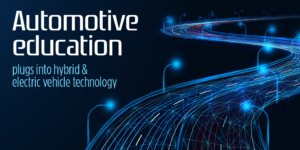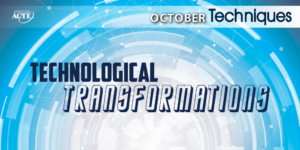Danny Camden, an automotive instructor in Indiana and vice president of ACTE’s Trade and Industrial Education Division, said the automotive classroom looks much different than it once did. Students today are preparing for an industry that has changed and is continuing to change rapidly. From advances in electric vehicle technology to a greater nationwide focus on sustainability, career and technical education (CTE) programs and their automotive industry partners are accelerating efforts to set students up for success.
“I always ask my students to name something that doesn’t have wires or some kind of electronics attached to it,” said Camden. “And there aren’t too many things — short of lug nuts — that you can find on a car anymore.”
While electric vehicles may still be uncharted territory for some consumers, they’re a content area that auto instructors need to embed in their curriculum, Camden said.
Darcy Wedel is a customer success manager for Electude, and he’ll lead two program sessions at ACTE’s CareerTech VISION 2022 in Las Vegas, Nevada. He told Techniques that the abstract nature of automotive electronics can make it challenging to incorporate into a hands-on learning environment. “When you teach a mechanical part of an automobile, you can roll an engine into the classroom,” he said. “You can put a wrench on the end of a crankshaft. And you can see the piston engines move up and down. You can teach students how that part works simply by taking it apart.”
In contrast to the traditional internal combustion engine fueled by gasoline, the electric vehicle drivetrain used in hybrid electric vehicles, plug-in hybrid electric vehicles, and battery electric vehicles is propelled by electromagnetism. Electromagnetism also makes other new technologies possible, like regenerative braking, which captures wasted kinetic energy from slowing the vehicle, converting it to energy to recharge its battery (U.S. Department of Energy, n.d.). And these changes in drivetrain technology aren’t the only changes happening in the automotive industry. CTE educators and students also must contend with developments in driver assistance technology, and automated driving.
Employers seek many of the same qualifications they always have: work ethic, proficiency with tools, and general auto knowledge. But now, automotive students in CTE also need a general understanding of electric vehicle technology. Yet we acknowledge that it can be challenging for teachers when the industry has changed so remarkably, and the new systems are unfamiliar. To better pre.pare students for an evolving workforce, automotive instructors can transform the student experience by employing some of these creative innovations in the classroom.
Be an automotive education facilitator, not an expert.
Wedel said that to adapt to this changing industry, instructors need to alter how they think about teaching. “I think if a teacher goes up there and lectures and talks about highly technical things as the expert, it often intimidates the students into thinking, ‘Wow, this per.son knows everything there is to know about this, but I’ll never get there.'” His point was that it’s okay for instructors not to know everything about electric vehicle technology.
Rather than spending time on becoming an expert, Wedel recommended investing in finding opportunities and environments for students to learn. “Don’t worry that you haven’t worked on an electric vehi.cle,” he said. “You’re probably going to be learning right alongside your students, but that’s okay. It shows the student the importance of lifelong learning.”
Set students up for success.
Teach them how to find information. The days when a car will come with a users’ manual are dwindling, Camden said. Instead, CTE students have to seek the right answers and be able to distinguish them as such. A critical skill Camden focuses on with students is teaching them how to use online service information. “Sometimes you have to do a lot of re.search to get to the right answer,” he continued. And an important part of research, he said, is learning how to evaluate information found on the internet.
Students need to know where to look, how to think critically and how to solve problems. These and other vital employ.ability skills can be helpful in learning how to stay current on changes in the industry. And this is true for students and educators alike.
Embrace technology.
Wedel recommended incorporating a lot of different tools in the classroom, especially when designing a blended or online course. Simulations, game-based learning platforms like Kahoot!, blogs, webinars, virtual tours and online discussions — when integrated strategically — can enhance students’ learning experiences. And not only do such tools increase engagement, but they also address the diverse learning styles of students. “There’s a lot of great resources out there,” he said. “Teachers need to be open to using them all.”
Further, technology can be used to connect educators with resources and opportunities that benefit themselves and their students. Camden said that his local automotive education organization — the Indiana Association of Transportation Technology Instructors (IATTI) — uses a Facebook page to foster networking and collaboration. In their online community, members share work opportunities for students, equipment available for sale (or donation) and upcoming professional development experiences.
Conclusion
Ultimately, Wedel said, it’s important to let an attitude of lifelong learning drive classroom adaptations to changes in the industry. While teaching electric vehicle technology may seem like a daunting undertaking to instructors unfamiliar with it, an open mind, a willingness to learn and a focus on sound problem-solving practices can carry a program through any evolution.
Laura Bengs is a freelance writer in the Midwest covering education, the arts, food, culture and finance. She is also a former educator. Her teaching experience includes courses in publications, writing, theater and literature at the high school and college levels.








